|
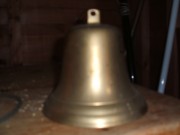
The Bell above has a 'Peg' argent on top of its crown.
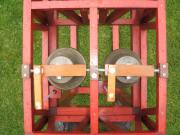
The bearings are visible in the image above which are covered with a Bearing Cap.
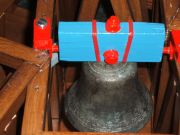
Bearing Caps are used to cover the gudgeon and its bearing as seen above.
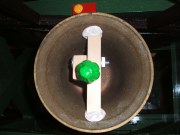
An image of Olympic Bell with its clapper tied, when the bell is next rung it will make no sound.
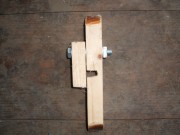
The image of a bell tie above shows the various aspects- angled ends to rest against the bells waist, a notch for the clapper to rest in and a pivoted swivel to hold the clapper in the notch.
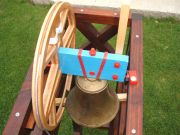
The red bars of plastic on the blue headstock above are 'Canon Straps' a method of securing a bell onto its headstock.
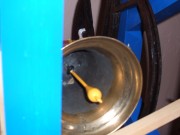
An image of the Britannic Bell from below shows its yellow 'clapper', the 'flight', 'ball', 'shank' and 'stirrup top' are all visible.
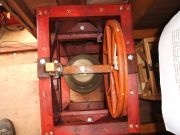
A bells 'crown' is the top of the bell and is secured directly to the headstock like this image of the Swiss Bell above.

This picture above shows a frames 'Cross-Braces', supports to add to the strength of the frame.
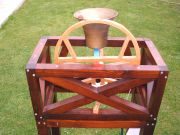
The image above clearly shows a frames 'cross-half' joint, instead of struts or cross-braces a wooden cross is formed at an angle and is then slotted into the frame.
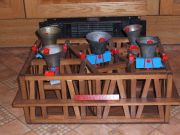
The Mini-Ring 'Bergholt Doubles' above is an example of the bells at East Bergholt in Suffolk.
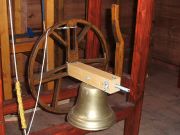
The Abbey Bell shows one of its gudgeons, another gudgeon will protrude from the wheel end of the headstock and act as pivots.
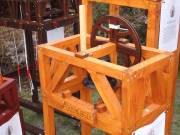
Although not visible, Fools Bell above has an independent clapper which is attached to the top of the headstock and secured with a nut.
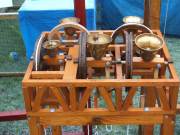
The bells above show the 'lip' or very tip of the soundbow the clapper strikes the lip and the bell sounds.
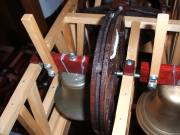
On the Headstocks above nuts and bolts are used to attach the stay and bell to the headstock, also the bearing caps are secured to the frame with the trusty nut and bolt.
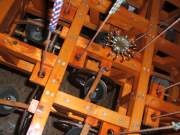
Caters Campanile can be seen from below and some of its ten ropes can also be seen along with their rope guides.
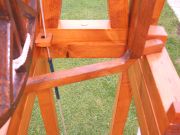
In the top, left hand side of this image a small rope guide is visible with the rope running through it. This is directly level with the wheel which keeps the rope from coming out of the groove of the wheel.
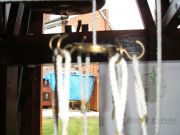
This image is of a rope pulley shows the tails or ends of the rope which are then hoisted into the top of the frame, the Mini-Ring it belongs to is 'Monks Minor'.

Another view of a rope pulley just right of the centre in this picture, Caters Campanile has ten bells so needs ten hooks on its rope pulley.
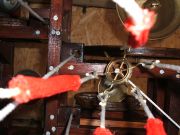
This image taken looking up into the frame of Monks Minor reveals a couple of the sallies which in this case are red but they can be of many different colours either multi-coloured or just one colour.
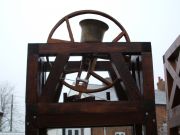
This picture shows a bells stay resting against its slider, the slider runs between two stops on a running block.
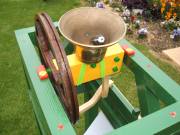
Another clearer view of how the stay and slider system allow the bell to be set in the 'up' position. Most sliders are curved at one end to allow the stay to reach it properly and not allow the bell or wheel to make contact with the slider.
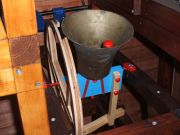
The Saxon Bell above in the raised position almost identical to the picture of the Olympic Bell above it.
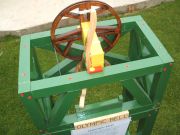
At the bottom center of the picture above, the slider and its running block can be seen, the block being the wooden object above the bells name plate, 'Olympic Bell' in this instant. When the stay next engages the slider it will be pushed from one end of the running block to the other. This action will be repeated over and over again as the bell is rung.
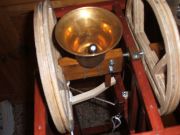
A partial view of Crossroad Bells showing the stay resting against the slider, when the bell is next pulled the stay will push the slider to the other end of the running block and rest against the 'stop'.
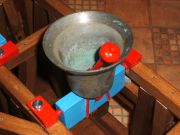
This picture shows a bell and its sound bow, the clapper strikes the sound bow and the bell sounds, while the bell is raised the clapper gently rests against its sound bow.

The clapper is secured with a staple as this image shows, the staple is firmly attached to the crown of the bell.
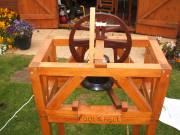
Fools Bell, above has a straight stay which is bolted to the side of the headstock, the tip of the stay is higher than the wheel and can easily reach the slider below.

This birds-eye view of the Swiss Bell reveals its 'stay box' where a socket is built into the headstock and the stay is then bolted into it. This type of headstock is unique on any of the models and mini-rings.
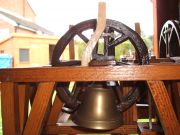
This bell, the number two of the mini-ring 'White Wheel Doubles' has a curved stay and the tip is level with the centre of the headstock.

The stay doing its job- allowing the bell set upside down, while the bell is 'up' the stay rests against the slider.

On the models, there is simply not enough force at work to break the bells stay, with the exception of a couple of the larger, heavier bells.

The Tbilisi Bell above weighing over eight pounds is heavy enough if over pulled for the stay to break off, just like a church bell in a tower.
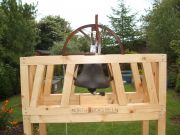
Another bell which is capable of snapping its stay is the North Bucks Bell which weighs over nine pounds, South Bucks Bell weighs the same and can also suffer a broken stay if pulled too hard.
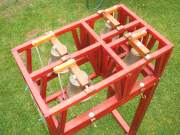
Minimus Four, above contains four bells which ring in the 'swing-chime' method. There is no wheel, stay or slider and the bells cannot be set in the raised or 'up' position.
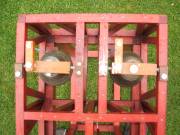
A partial birds-eye view of the Minimus Four mini-ring, the chiming bars can be seen with the rope tied to the far end. Each bell will only swing slightly during chiming.

This image reveals the number three and four bells of 'Minimus Four', the number four bell's chiming bar (left bell) is slightly longer than that of the chiming bar which belongs to bell number three (right bell).

This picture of a rope pulley shows the tail end of a bell rope which is looped and is part of the rope which is grasped by the ringer during bell ringing.
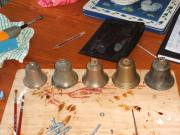
These five bells which were later to become the mini-ring 'Bergholt Doubles' show the 'waist' or midsection of the bell.
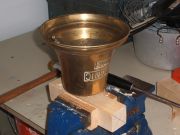
This is 'Britannic Bell' during its construction, engraving can be seen on the bell in the middle, this part of the bell is the 'waist'.
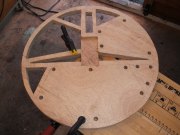
A wheel during its construction, each 'segment' of wood is cut out to form the wheels spokes.
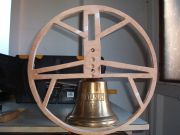
The same wheel as above after being cut out but before being varnished, it is also attached to the headstock but will later be removed and varnished.
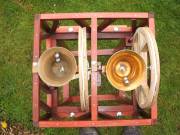
Although most wheels are varnished 'dark oak', the two examples here have been varnished 'clear'.
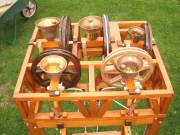
White Wheel Doubles is unusual in having four of its wheels coloured 'Dark Oak' but the fifth is coloured clear, that is how the name of this Mini-Ring came about- 'White Wheel'. |

MODEL CHURCH BELLS
Glossary
This page lists the key parts and their meaning of a Model Church Bell beginning from A-Z.
Argent- A small 'peg' which protrudes from the bells 'crown' which is inserted into a recess which is cut into the headstock as a way of suspending the bell onto its headstock.
Bearing- The two notches which are cut into the side of the frame for each of the gudgeons or pivots to rest which allow the bell to swing on its headstock, the bearings are hidden with a 'bearing cap'.
Bearing Cap- A slide of wood which slides over the bearing and its gudgeon, these caps are pivoted in order to be opened to enable the bell, headstock, stay and wheel to be lifted out of its frame.
Bell- The metal object which sits in between the wheel and the stay and goes 'ding'!. It is also attached to the headstock.
Bell 'Tie'- A bell 'tie' is a length of wood which is designed to silence the bell during ringing. A tie is inserted into the inside of the bell and holds the clapper in a central position preventing it from striking the soundbow, bells are tied usually when a person is learning to ring so as not to create too much noise which can disturb people living near the church. Sometimes a model bell will be tied if it is used for demonstration purposes.
Canon Strap- The bars of wood or plastic which are attached to the headstock above the bell which are used in church towers to secure the bell to its headstock, although on the models they are purely decorative and serve no mechanical use but just add to that 'finishing touch'.
Change-Ringing- The English method of Bellringing which is virtually unique to the British Isles, complex methods of ringing which can include many thousands of 'changes'. 'Peals' (A session of change-ringing will normally last three hours with thousands of changes and no stopping!).
Clapper- The bells 'tongue' or the bar of metal which hangs inside the bell and strikes the bells 'soundbow' in order to sound it. The clapper normally has four parts- the 'hook' or 'stirrup top', the 'shank', the 'ball' and the 'flight' although most clappers on the models do not include all these parts.
Crown- The top of the bell which is either flat or includes an 'argent'.
Cross-Brace- The 'struts' of wood which are inserted diagonally in the frame which give it support and add a more realistic and tidy look.
Cross-Half joint- Instead of 'cross-braces' wooden crosses are cut to size and fitted into the frame, a notch is cut into the centre of each piece and the two pieces are then slotted together. These are far more difficult and time consuming to make than the more common 'cross-brace' and most models have cross-braces instead of cross-half joints.
East Bergholt- East Bergholt is a small town in Suffolk, England. In the churchyard of East Bergholt there exists a very unique and unusual ring of five church bells, these bells are not hung in a frame high up in the church tower but rather in a 'bell cage' in the churchyard and are hung at ground level, each bell is suspended on a headstock but there is no wheel, slider or rope. The bells have to be pushed over by hand and then stopped after they have turned full circle. The Mini-Ring 'Bergholt Doubles' was made to give an idea of how these very unusual bells look and ring.
Gudgeon- The 'pivots' which protrude from each end of the headstock and rest in the frames 'bearings', the gudgeons allow the bell to swing freely and sometimes have a square nut on each end which acts as a bearing.
Independant Clapper- An 'Independent Clapper' is when a clapper is not attached to the inside of the bell rather it is joined to a bolt which passes through the top of the bell, through the headstock and is secured to the top of the headstock with a nut.
Lip- The very tip of the bottom of the bell on the end of the 'soundbow' which is struck by the clapper in order for the bell to sound.
Nut and Bolt- The best invention since the development of the wheel!. Nuts and Bolts are used widely through out model making, attaching stays to headstocks, bells to headstocks, sliders to frames and much more. A Mini-Ring can contain upto fifty nuts and bolts- wonderful things!.
Rope- The length of cord which each bell has in order to ring it, the rope is tied around the top of the wheel and runs in a groove around the wheels circumferance. Towards the bottom end of the rope is a 'Sally' which is used to grip the rope securely during ringing.
Rope Guide- A rope guide is a small square or rectangular block of wood which sits in the frame directly below the wheel, this has a hole drilled through the center which the rope passed through. The rope guide keeps the rope from coming out of the groove of the wheel during ringing by keeping the rope level with the wheel, the rope guide is directly level with the wheel and is underneath the whole bell assembly.
Rope Pulley- In a church ringing chamber the bells are often left in the raised or 'up' position for sometimes days at a time, this is because the team of ringers would normally ring on a Sunday prior or sometimes after a Sunday service. They may also have their practice night early in the week like on a Monday or Tuesday for example so in order to save time (and energy!) the bells are left 'up' so that they don't have to be rung 'down' or 'up' at the start and finish of every ringing session.
Leaving the bells in the raised position can have its dangers because an inexperenced or non-ringer could get into the ringing chamber and attempt to pull on the ropes or try to ring the bells, this could and has led to serious even fatal accidents- if a raised church bell is pulled off incorrectly the ringer or non-ringer could be pulled many feet off the ground (sometimes 30 feet) and then fall back down onto the floor below or even strike the ceiling of the ringing chamber resulting in horrific injury.
As a safety feature, many towers have whats called a 'rope pulley' which is lowered from the ceiling of the ringing chamber and then the tails of the ropes are attached to serveral hooks on the pulley, this is then hoisted back up into the ceiling of the ringing chamber thus lifting the ropes high off the ground and out the way of any inexperienced ringer or visiting non-ringer. The rope pulleys on the Mini-Rings do the same as in a tower but are mostly for decoration as there is no danger of being injured by a bell weighing only 10 ounces!.
Sally- This is a length of thick, fluffy material which is part of the rope and acts as a grip for when the bell is being rung, the sally is normally three feet long and is situated near the tail end of the rope, it is usually striped with three different colours but can just be all one colour. On the models the sally is a short length of coloured cord and its length is usually the same as the height of the bell, the sallies on each model are mainly for decoration rather than for functional use and make the model as realistic as possible.
Slider- The slider is a bar of wood which sits in the frame below the bell, it is fixed at one end and is designed to slide on a running block at the other end, its purpose is to allow the bells 'stay' to coincide with it during ringing. As the bell swings further towards the balance the tip of the stay will make contact with the slider and push it between the sliders 'stops' hence why it is called the 'slider'. This simple mechanical arrangement allows the bell to 'set' in the raised position and when the rope is next pulled the bell will turn full-circle, the stay will meet the slider again- pushing it over its running block and the bell will set upside down again.
Slider Running Block- As the bell is being rung and is reaching its point of balance, the tip of its 'stay' will be engaging with the 'slider', once the stay rests against the slider the bell is raised and rests upside down. For the slider to hold the weight of the bell and its headstock and allow the stay to rest against it a block of wood is located in the frame on the opposite side to the wheel, this block has a 'stop' at each end and is there for the curved end of the slider to travel along as it is being pushed by the stay. The two 'stops' at each end of the block stop the slider from sliding too far over each time it is being pushed along the running block by the stay. If the slider travels too far from stop-to-stop then the stay would run short of the slider and the bell would swing right over and be potentially dangerous to the ringer below.
Sound Bow- The flared bottom of a bell which is struck by the ball of the clapper which sounds the bell. At the very tip of the sound bow is the 'lip' as described in the glossery earlier.
Staple- Inside the top of the bell overwise known as the 'crown' the clapper is held in place by a staple which is attached either to a bolt which secures the bell to its headstock (Independent Clapper) or is bonded to the bells crown itself. The 'North Bucks' and 'South Bucks' bells have a re-inforced staple which runs throught the bell and is firmly attached to the headstock, this is because of the sheer weight of the clapper which is about 2lb in weight.
Stay- The 'Stay' is the bar of wood which is attached to the headstock on the opposite side to the wheel, its length is usually calculated in order for its tip to protrude slightly higher than the top of the wheel. The sole purpose of the Stay is to enable the bell to be set in the raised or 'up' position, this is achieved when the Stay coincides and then rests against the Slider in the frame below the bell.
The bells 'Stay' can be either a curved or straight bar of wood which in most cases is bolted to the side of the headstock although occasionally the headstock can incorporate a 'Stay Box' which is basicially a socket for the stay to rest in. Almost all of the models have bolt-on stays with only the 'Swiss Bell' model having a wooden 'Stay Box' made of plywood. With curved stays the curve in the wood is cut in order for the tip of the stay to be level with the centre of the headstock, these are more difficult to cut than the straight stay and are slightly weaker due to them running against the 'grain' of the wood.
Stay- 'Breaking a Stay'- When church bells are being rung the force both sideways and downwards is extreme, if a bell is over pulled or being badly rung allowing the stay to bang hard against the slider some sort of 'safety valve' has to be activated because of the sheer amount of force being applied to the bell, its fittings and the frame, something has to 'give' in order to prevent serious damage occuring to the bell and/or its gear if the bell is being misused. If the bell is pulled too hard the stay will hit the slider with such force that the stay will break- the stay is designed to break or snap off to allow dangerous amounts of force to be dissipated preventing far more serious damage from taking place.
This is exactly like the safety valve on a pressure cooker- to safely 'bleed-off' any dangerous or damaging amounts of force. If a stay does get broken then there is nothing to stop the bell from swinging fully over and winding its entire rope around the outside of the wheel, this is protentially dangerous situation for the bellringer to be in for if he or she does not instantly let go of the rope then they could be pulled several feet off into the air and then fall back down to the ground below. In very rare cases this has proved fatal due the distance a person can fall after being pulled up into the air and then dropped back to the floor below. The stay usually breaks off at a point near the headstock leaving a short stump of wood attached to the headstock and a church bell cannot be rung again until the stay has been replaced with a new one of the same length.
Swing-Chime- The term 'Swing-Chime' is a primative method of sounding a church bell, the bell is only swung slightly from side to side in order to make it sound. The bell is secured to a headstock with a chiming bar bolted to one end of the headstock, a rope is tied to the very end of the chiming bar and once pulled will swing the headstock and its bell in order to make the bell sound. A good example of how swing-chime bells ring is the mini-ring 'Minimus Four' which contains four bells which are hung in the swing-chime fashion.
Tail- This is the very end of the bell rope and finishes in the form of a loop which is held by the ringer, this part of the rope is never let go unlike the 'sally' which when the bell is pulled off the ringer lets go of the sally but holds onto the tail of the rope. If a stay gets broken then the ringer has to let go of the tail end of the rope to prevent being lifted many feet into the air which could and has let to serious or even fatal injuries.
Waist- Another part of the church bell itself, the waist is the midsection above the soundbow and below the crown, some old bells have inscriptions placed here- the name of the bell, the year it was cast and by which bell founder etc.
Wheel- The wheel is the large circular object which is joined to the headstock on the opposite side to the stay. The spokes of the wheel are cut to a very unique pattern, there is a groove which runs the entire circumferance and a tiny hole is drilled in the groove near the top of the wheel for the rope to pass through, this is known as the 'garter' or 'fillet' hole and when the rope has been guided through this hole the two top spokes act as a area for the rope to be tied onto the wheel.
Each wheel is made of 'plywood' which is a man made sheet-wood which is very strong and is used for many different purposes, it takes on average forty hours to produce each wheel which involves drawing, cutting, sanding, glueing, drilling and varnishing. Most wheels are varnished in the 'Dark Oak' style but some are varnished others colours as well, since the first model was made in September 2005 around sixty bell wheels have been made.
|